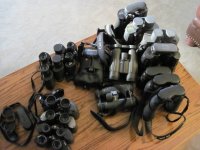Gijs has raised some interesting points. I suppose the Habicht and other top Porros enjoy the transmission advantages of optical simplicity, with their cemented doublet objectives, lack of extra focusing lenses, and simple eyepieces.
The Fujinon FMT-SX has been 95% transmitting since its introduction about 30 years ago, and that is an average over the main visible band, not the peak. My FMT is obviously brighter than my FLs, and it is an original model. The coatings were improved with a rumored 2% gain about ten years ago.
In addition to its old school Porro simplicity and excellent coatings, the Docter Nobilem has another transmission advantage that I don't see how can possibly be beaten. The two prisms making up its Porro cluster are cemented together, so there are only two air to glass transitions.
And no, neither Habicht, FMT nor Nobilem mention the use of any modern especially transmitting glass. If they did, look out.
Even in the HT generation, Porros will remain the most transmissive of binoculars. As a roof fan, I find this irritating.
Ron
The Fujinon FMT-SX has been 95% transmitting since its introduction about 30 years ago, and that is an average over the main visible band, not the peak. My FMT is obviously brighter than my FLs, and it is an original model. The coatings were improved with a rumored 2% gain about ten years ago.
In addition to its old school Porro simplicity and excellent coatings, the Docter Nobilem has another transmission advantage that I don't see how can possibly be beaten. The two prisms making up its Porro cluster are cemented together, so there are only two air to glass transitions.
And no, neither Habicht, FMT nor Nobilem mention the use of any modern especially transmitting glass. If they did, look out.
Even in the HT generation, Porros will remain the most transmissive of binoculars. As a roof fan, I find this irritating.
Ron








